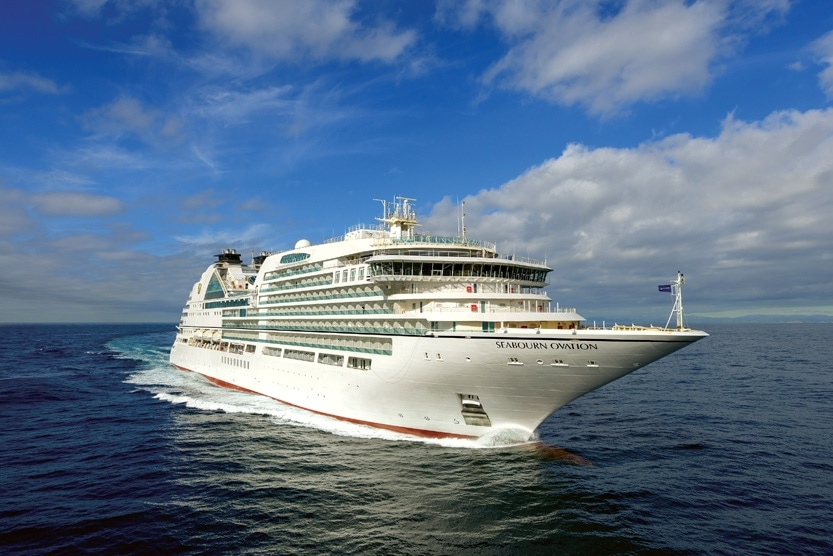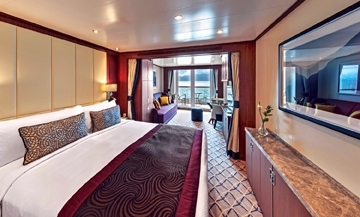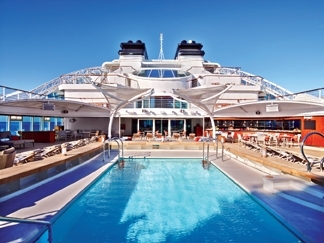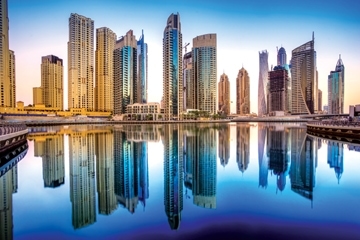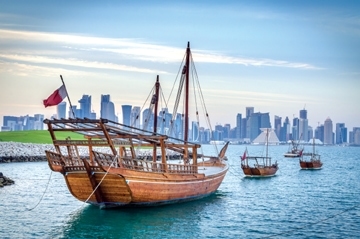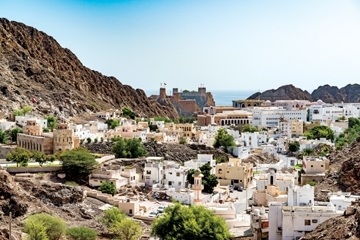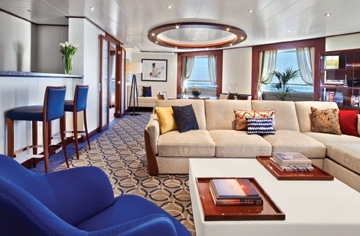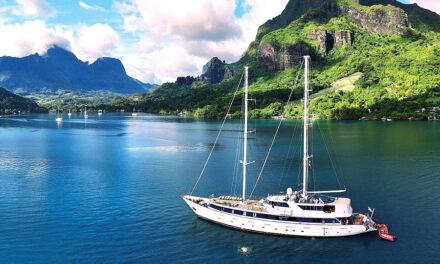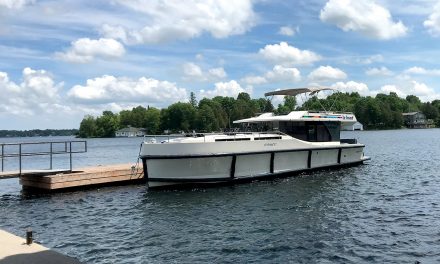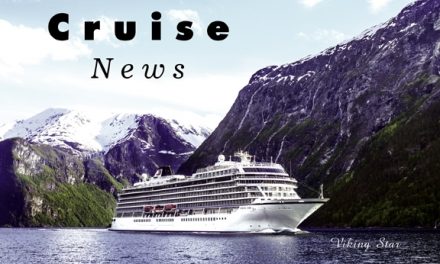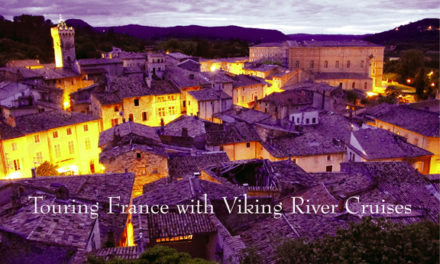Cruise
Adventuring Around Arabia Aboard Seabourn Ovation
by Olivia Balsinger
It was only 5:04 am, yet that drastic Arabian sun was eager to heat the stark and rugged landscape of Muscat, Oman’s capital port city. Still jetlagged, I had meandered to the 10th floor of the Seabourn Ovation, the refined ship that would be my home for 21 days as we snaked around the Arabian Peninsula, beginning in Dubai and culminating in Athens, Greece on the “Arabia and Antiquities” itinerary. Though I had previously traveled extensively through the more developed and glitzy Arabian Gulf cities, this journey continued to surprise and enlighten me about the involved past and naturally stunning parts of this region.
I looked over the balcony. The sun began to illuminate the elegantly understated Muscat, graced on both sides by the arid Hajar mountains. An outlier to the stereotypically perceived flat landscape, in that moment I knew Muscat—like all the other stops on this journey – would be magical.
Though we enjoyed the luxurious, world-class treatment we experienced onboard the Ovation during our sea days in transit, the highlight of this adventure around Arabia was exploring new lands on port days, enjoying the ship’s varied excursions. The following are highlights of our port adventures with Seabourn.
Dubai and Sir Bani Yas Island, UAE
Our journey began in Dubai, the glitzy capital of the United Arab Emirates. Home to some of the world’s most dramatic buildings and constantly at the height of innovation, my boyfriend and I spent our day getting lost in the chaos and glitz. We saw the world’s first indoor ski slope, climbed to the highest floor of the 282-meter high Burj Khalifa and walked along the Corniche Deira, the picturesque seaside promenade. In the early evening we headed to the cruise terminal to begin our journey, sailing away from the and towards one of the UAE’s natural phenomenon, Sir Bani Yas Island.
In total contrast to our chaotic day in Dubai, our first port Sir Bani Yas Island was calm, vastly different than any “beach destination” I’ve ever visited. We arrived to onshore melodies and glasses of sangria delivered by Seabourn white gloved waiters and waitresses. After toasting in the sun for a bit, it was time to embark on our tour to explore the more remote areas of the island past the beachfront and hopefully spot wildlife. With the insight of a local and knowledgeable guide, we were given an introduction to the island’s history. We learned that about 7,000 years ago The Bani Yas tribe left the island desolate – there were no trees or freshwater sources on the island and the shorelines were barren. When the UAE’s founder, Sheikh Zayed bin Sultan Al Nahyan, spontaneously visited the island, he transformed it into a sanctuary for endangered animals from Arabia, Africa and beyond. One stop on the tour we found particularly fascinating was the Falcon Hunting Point, where we learned about the history of this fierce bird and how they have shaped hunting in the UAE. The tour gave us interesting perspective into the history of Sir Bani Yas Island and how the past has shaped what it has turned into today.
Doha, Qatar
The next day we arrived in Doha, Qatar’s capital and a land of innovation and where tradition greets modernity. From the world-class metropolis of Doha, brimming with museums, nightlife and unrivaled man-made architecture, to the natural phenomena in the deserts, Qatar maintains all aspects of its heritage while embracing the new world. And each of the optional Seabourn excursions served to showcase Qatar’s complexities. One excursion that Seabourn guests could choose, for example, was entitled “Doha City Highlights,” and included a panoramic drive along the Corniche – the four-mile costal route that stretches from the Museum of Islamic Arts to West Bay, a stop at the Pearl of Qatar – an artificial island that evokes the architecture of Venice – and shopping time in the labyrinth of alleyways that comprise the Standing Markets. We visited the Souq Waqif, one of the most traditional in the Middle East, to find pearl shops and nooks where men still gather to chat.
Salalah, Oman
Salalah is famous for its Arabian Sea beaches, fruit plantations and waters brimming with sea life. Though during our visit the area seemed extremely desert-like, with rolling desert dune and a strikingly dry heat, we learned from our tour guide, Mohammad, that the landscape completely changes come summer. The Khareef, an annual monsoon, transforms the desert terrain into a lush, green landscape, even creating seasonal waterfalls. We decided to embark on another Seabourn excursion today, “Sultanate Heritage: A UNESCO Partner Tour,” in order to begin and understand the dynamic and fascinating history of the region. After leaving port we visited Al Balid, a UNESCO World Heritage Site and once a prosperous medieval-era port. We enjoyed free time exploring the well-preserved fort and also learning about its history—I was baffled to learn it was once one of the world’s most important harbors for the export of frankincense.
After visiting these archaeological ruins, we drove to Taqa, another ancient center of the frankincense trade. Today the area is actually a populous fishing village renowned for its traditional white-stone houses and its historic castle. We walked around for a bit on our own before driving to Samhuram, located near the great lagoon of Khor Rouri Creek. This UNESCO World Heritage Site dates back to 3000 BC and vividly illustrates the heyday of Arabia’s frankincense trade with the Far East and Greece.
Muscat, Oman
Muscat is famed for its intricate souk mazes, fresh seafood, stunning backdrops and that effusive Omani hospitality. We spent the morning getting acquainted with Omanis at the local fish and vegetable market through Seabourn’s “Shopping with the Chef” option excursion. The market, located at the end of the Corniche, is best to visit in the early morning hours, especially with both an English speaker who understands “market talk” and a local guide who can assist in
translations.
Accompanying us was the Executive Chef of Seabourn Ovation, Jes Paskins, who led us around the market, negotiating prices for fish which we would actually be cooking onboard. It was a unique way to explore the Muscat food scene, battering with the Omani fishermen who were flaunting their “catch of the day.” Between giant tuna, stingrays, baby sharks and a massive father shark, our senses were in overdrive in the best possible way. We ended up purchasing enough queen fish, king fish and tuna to feed our ship of 600 passengers. Next, our chef led us through the labyrinth of ceramics, jewelry, and spice scents that make up Muscat’s Mutrah Souq. The Souq is an essential visit for both shoppers and people- watching enthusiasts. One of the oldest shopping centers on the Arabian Peninsula, it is nicknamed “the dark souk,” referring to its especially winding and dim interior. Bargaining is the language of the souk stalls, though there is less wiggle room with jewelry. Spices such as frankincense, butter-solve wool pashminas and leather are some of the most popular items for purchase. It was here that we bought spices that Jes would be using in meals onboard, to give them a certain Arabian kick.
Seabourn is known worldwide as a top-tier cruise line, delivering that human touch on a state-of-the-art ship. Though one could spend days onboard the Ovation indulging in the unlimited champagne and caviar, enjoying the multiple restaurants and tanning poolside, what separates Seabourn from it’s competitors are the engaging excursions in exotic ports around the world.
www.seabourn.com

